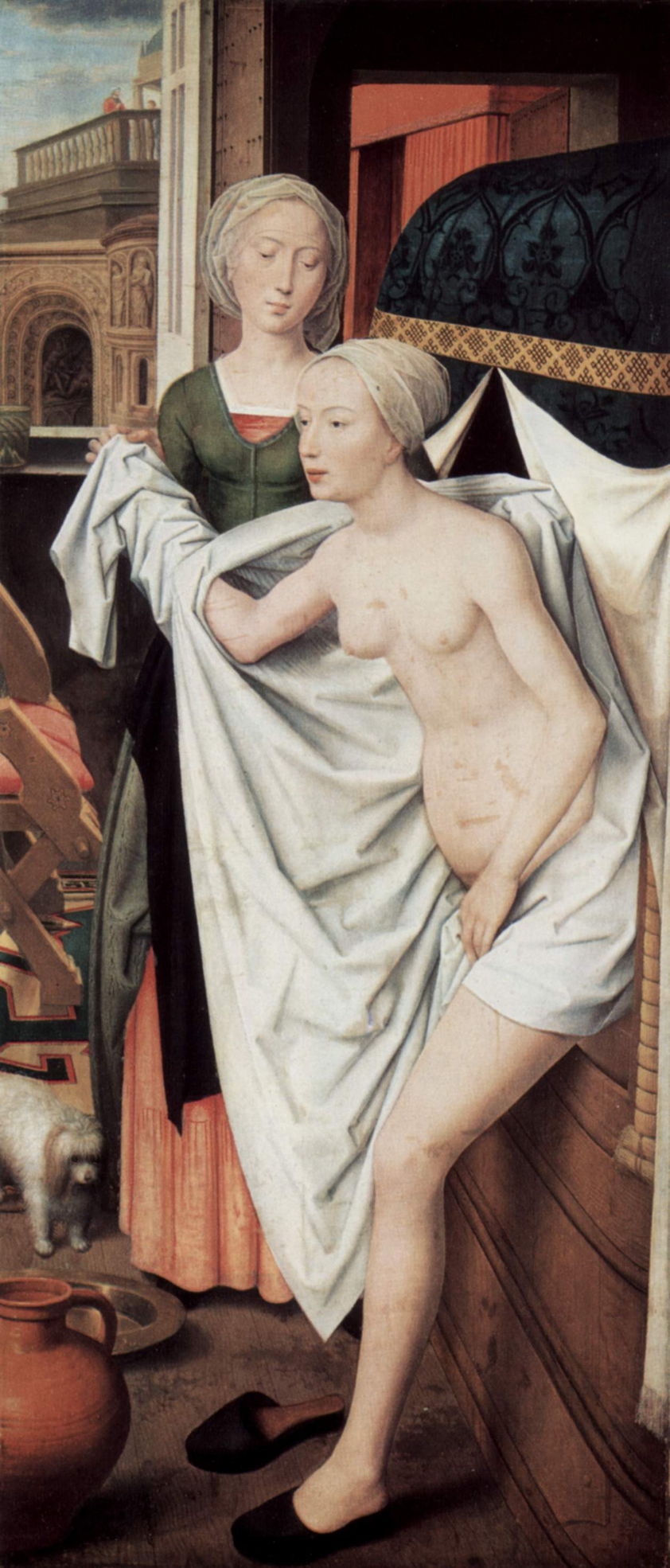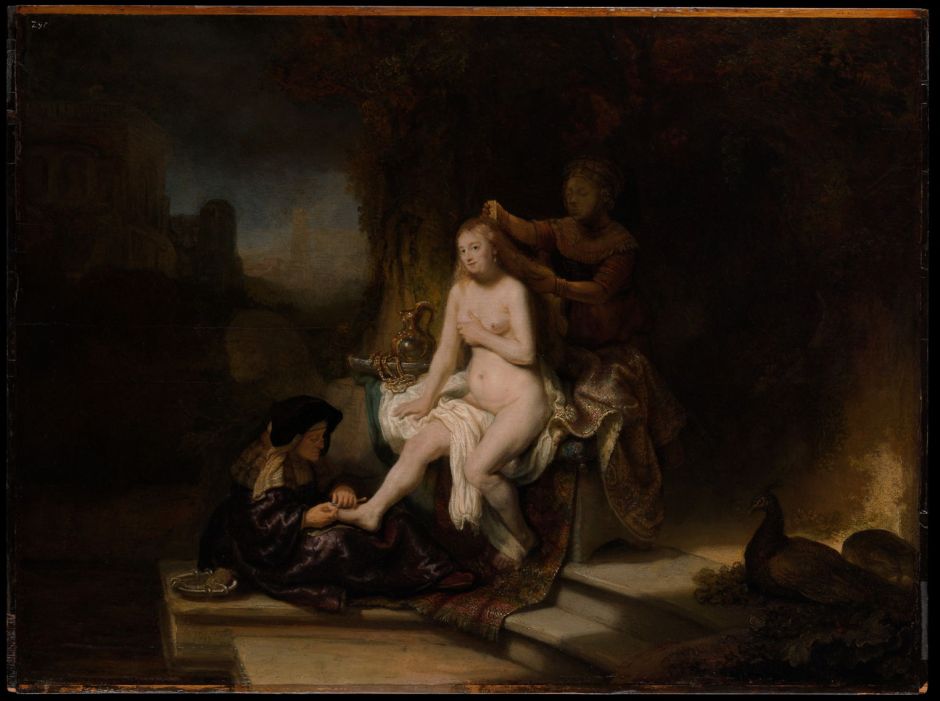At the start of this month I looked at one of the most popular stories from the Old Testament featuring a woman in its leading role, that of Susanna and the Elders, where Susanna’s virtue is maintained and eventually rewarded. This weekend I look at another Old Testament story with some superficial similarities, in that it starts with a virtuous woman being watched while she bathes, but ends up both more sordid and decidedly anti-moralistic: that of Bathsheba and King David.
This comes from the Old Testament (second) book of Samuel, and has long been a favourite of artists. As with the story of Susanna, it has been seized upon by some as an opportunity to paint a female nude (or partially nude) in an ostensibly religious work. But a fuller account can contain intense psychological drama, and the whole narrative is surely about the abuse of power.
When King David was walking on the roof of his palace, he saw the wife of Uriah, one of his generals, bathing, and he lusted after her. David then seduced Bathsheba, and made her pregnant. In a bid to conceal his adultery, he recalled her husband from a military campaign, in the hope that he would sleep with his wife and enable her pregnancy to be ascribed to him. That ploy failed when Uriah didn’t go to his own bed. David therefore despatched the general to the front line, in the expectation that he would be killed, which he was. With Bathsheba now widowed, David was able to marry her.
King David was brought to confess his sin and to repent for it by Nathan the prophet. He and Bathsheba were punished when their child died soon after birth. But their next child was Solomon: Bathsheba persuaded David to make him first in line to the throne, and on David’s death he became King Solomon the Wise.
As with Susanna and the Elders, the story of Bathsheba and King David had already become established during the late Middle Ages in miniatures illustrating the Old Testament; I show a fine example below. Come the Renaissance it started to appear in paintings, particularly in northern Europe.

Hans Memling’s Bathsheba Bathing from 1485 is one of its earliest depictions, in a composition which doesn’t appear to have been copied later. Bathsheba is being assisted by her maidservant from her closet-bed, a traditional Dutch bedstede, with King David visible on a balcony in the distance. It isn’t clear whether her maid is wrapping Bathsheba in the white gown, or undressing her ready to wash using the pitcher of water and bowl at their feet.

Miniatures, such as Jean Bourdichon’s Bathsheba Bathing from 1498-99, led more private lives and could be considerably more explicit. Here is the most frequently painted moment of the story, with a nude Bathsheba bathing in the foreground, and David in his crown and regal robes watching her from a window in the distance.
This composition affords the viewer the full splendour of the nude while not entirely forgetting the story which provides the excuse. As narrative, though, it’s weak and offers no links to the subsequent story.
An interesting contrast between this and the early depictions of Susanna and the elders is that Bathsheba is shown bathing almost in public, whereas Susanna is conventionally seen in a secluded spot, with the elders having intruded into her privacy. The implication is that Bathsheba played a role in instigating her seduction by the king, a theme absent from the text.

Other paintings of the story were extremely prim and proper, such as Lucas Cranach the Elder’s David and Bathsheba from 1526. Bathsheba sits with her feet being washed in a small pond, and doesn’t even get to expose her knees, heaven forbid. Watching from immediately above her, King David is given a harp in his role as a psalmist, and is accompanied by members of his court.
A few artists chose scenes from later in the story, some of which became quite explicit.

Salviati’s fresco of Bathsheba Goes to King David from 1552-54, for instance, shows the couple making love naked in the chamber at the top of these unusual stairs.

Later paintings have attempted to provide more visual cues to their context. In Jan Matsys’ David and Bathsheba of 1562, the scantily-clad Bathsheba is in discussion with one of the king’s court, who has been sent down to express the regal interest. The maid who has been bathing Bathsheba’s feet appears to know well what is going on, judging by the wicked smile on her face, although Bathsheba’s reaction is harder to read. Perhaps the best clue to the reading is with the two dogs: the sleek hound that has arrived with the king’s messenger is about to pounce on Bathsheba’s small lapdog.

In his Bathsheba at Bath from about 1575, Paolo Veronese keeps Bathsheba almost discreetly covered, and has brought down either David or a senior member of his court to discuss the king’s interest in her. Others stand in a small huddle at the far side of the courtyard, to the right, but the artist provides an explicit hint in the statue visible at the upper left: they aren’t discussing the weather.

Hans von Aachen’s attempt to tell more of the story in his David and Bathsheba of about 1612-15 meets with mixed success. The key figures of the nude Bathsheba in the foreground and King David high on the balcony at the upper right are essentials. For once, Bathsheba is shown at her toilet, drying her left foot, and with a small collection of grooming tools on the table in front of her.
The puzzle here is the figure standing behind Bathsheba, holding a mirror in front of her face with his outstretched left arm. That could have been her husband Uriah, and he’s wearing a helmet, but at this stage of the story, Uriah should be away on campaign and his wife is bathing alone.
A glance at Bathsheba’s reflection in the mirror says that something is seriously amiss: von Aachen has painted a reflection in which Bathsheba is looking to the left, although her face is actually looking to the right. No single plane mirror could ever achieve that optical impossibility. This painting leaves us with several unresolved issues, but little better idea of the original story.

In about 1635, during his late career, when he had officially retired, Peter Paul Rubens painted Bathsheba at the Fountain. She looks dreamily into the distance as her hair is combed and prepared by a maid. Her lapdog is barking, as if to alert her to the far gaze of the king, who is leaning over his balcony at the upper left.

Artemisia Gentileschi painted this story at least twice. On the first occasion, she is thought to have enlisted the assistance of Domenico Gargiulo and Viviano Codazzi to provide the landscape and architectural background for her Bathsheba of 1637. This follows established practice, with Bathsheba nearly nude in the foreground, being assisted by several maids. Behind, from the vantage point of his balcony, King David watches what is going on.

A few years later, Artemisia Gentileschi tried a different setting, this time at night, in her Bathsheba at Her Bath from about 1640-45. Bathsheba now has a mirror on her thigh, but no reflection is shown in it. David seems to have all but vanished into the far distance here.

Rembrandt’s first painting of Bathsheba at her Toilet from 1643 isn’t one of his better works. It followed the popular trend, only his model was past her best, and the distant voyeur king has disappeared into the gloom of old varnish, I presume to the left. But over the next dozen years, the artist came up with a very different treatment to address some of the issues raised by the Old Testament story, and so starts my next article.

